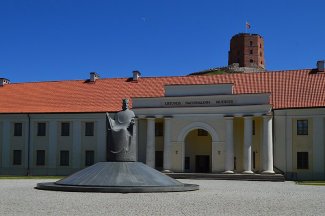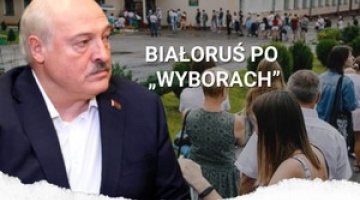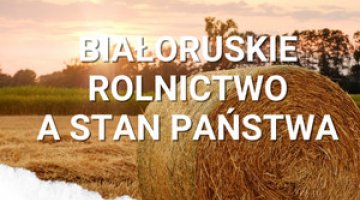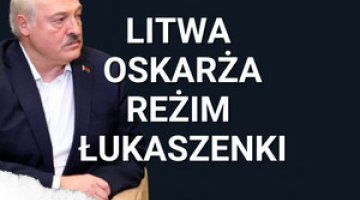A difficult legacy. Tensions over how to interpret the shared past of Lithuanian and Belarusian peoples

Hostile attitudes towards Belarusians in Lithuania have become more widespread as a result of the Russian invasion of Ukraine with Belarus’s involvement. This animosity has been further exacerbated by the ongoing debate in the Lithuanian media about how to interpret the two nations’ shared, centuries-old history. The key context for these tensions is the significant growth of the Belarusian diaspora in Lithuania over the past four years (c. 63,000 people) and the influx of 86,000 Ukrainian citizens and 16,000 Russians following the outbreak of war in 2022. This situation has confronted Lithuanian politicians and special services with the challenge of identifying and preventing possible threats. They have been closely monitoring efforts to disseminate radical, nationalist, and other views inspired by Belarusian and Russian special services with the aim of dividing the two nations. Such views include the concept of the so-called ‘Litvinism’, a pseudo-scientific theory which claims that the medieval Lithuanians were in fact Belarusians and that they founded the Grand Duchy of Lithuania (GDL). If this theory were to be legitimised, Lithuania’s right to the Vilnius region could be called into question. Leaders of the Belarusian diaspora have supported Lithuania’s position that rejects Litvinism and have viewed any efforts to popularise this idea as attempts to drive a wedge between the two nations.
The origins of Litvinism
The roots of this concept go back to the early 20th century when some Belarusian nationalists attempted to create a national identity from scratch. The Litvinists claim that the GDL, which encompassed the area of present-day Lithuania and Belarus, was founded by Belarusians and that they are the sole heirs to its legacy. In their view, the medieval Lithuanians were in fact Belarusians, while the present-day Lithuanians are the former inhabitants of Žemaitija (Samogitia) who never formed their own state. Many Litvinists have embraced the thesis that the GDL was founded in Novogrudok by Mindaugas, who they believe was a Ruthenian prince. This is also where they situate Voruta, the legendary seat of the Lithuanian prince, even though there is no historical evidence to support this. Some of them accept that the GDL was a Baltic-East Slavic state, in which the Slavs were dominant both numerically and politically. Meanwhile, some proponents of Litvinism’s most radical version have gone as far as to make territorial claims over the Vilnius region, including the city of Vilnius, which they consider to be exclusively Belarusian.
The pseudo-historical essays of retired Belarusian historian and writer Mykola Yermalovich, which were published in samizdat in the 1980s and later officially in independent Belarus, gained the greatest publicity. His theory on the GDL’s origins in the Novogrudok Land, which were within the borders of the Belarusian Soviet Socialist Republic (BSSR) and later the Republic of Belarus, became part of Belarusian society’s historical consciousness, particularly among those striving for democratic changes. Thus, the concept that portrayed the GDL as an exclusively Belarusian entity, which historians had rejected, made its way into domestic historical journalism. After 2000, this idea was given further prominence by Anatoly Taras,[1] author of widely-read books on Belarusian history. According to another Belarusian historian, Ales Bely, there are currently only a few dozen proponents of extreme Litvinism (though they have not called for territorial annexation), but this ideology has been gaining a much wider audience as social media has boosted its reach and popularity.[2]
Alyaksandr Lukashenka has also made references to Belarus during the GDL era. Initially, after coming to power in the 1990s, he claimed that the GDL belonged to the Lithuanians and that Belarus was only formed after the October Revolution. However, in 2005, when he sought to distance himself from Russia and move closer to the EU, he began highlighting his country’s European roots and, to this end, referred to the legacy of the GDL as a Belarusian state that was also home to Lithuanian people.[3] He rebuilt palaces and castles from that period and erected monuments to Lithuanian rulers: Prince Algirdas in Vitebsk in 2014 and Prince Gediminas in Lida in 2019 – but without identifying their origins. After the opposition staged mass protests in 2020, the dictator reversed course on the politics of memory. His regime began persecuting historians who studied the GDL and the Litvinists, while statues of Vytautas and Jogaila were removed from the Historical Museum in Minsk as they were considered Polish occupiers.[4]
Litvinism as a threat to Lithuanian statehood
The theory of Litvinism strikes at the foundations of Lithuanian statehood and challenges the nation’s medieval history, as the country currently celebrates Statehood Day on the anniversary of the coronation of Mindaugas, Lithuania’s only king. As early as 1991, following the collapse of the Soviet Union, Lithuania protested when sovereign Belarus adopted the Pahonia as its national symbol in a version similar to the emblem of independent Lithuania. The dispute over symbols posed a challenge for the government in Vilnius, which sought to settle its political and territorial relations with Belarus as soon as possible, including through references to the two nations’ shared history in the GDL and their common struggle against the Russian Empire. However, there were concerns that Litvinism’s influence could spread and evolve into a state ideology, especially as Belarusian officials occasionally claimed that the Vilnius region should belong to Belarus.[5]
These fears diminished in 1995, after the two countries signed a treaty on good neighbourliness and Belarus held a (rigged) referendum that resulted in the restoration of an emblem similar to that of the BSSR. The feelings of insecurity among Lithuanians were further eased by the emergence of Belarusian historians who sought to engage in a scholarly dialogue around the GDL’s shared Belarusian-Lithuanian legacy. Today, historians from both countries regard Litvinism as a pseudo-scientific theory.
However, Lithuanian historians have criticised politicians for neglecting education and lamented the lack of knowledge about the two nations’ shared history in both countries (with some Lithuanians also cliaming the GDL’s legacy as solely their own). In their view, this lack of understanding makes it easier to manipulate public sentiment with pseudo-historical narratives.
The current debate about Litvinism in Lithuania
In mid-2023, an intense debate about Litvinism, which had allegedly regained popularity again among the Belarusian diaspora in Lithuania, emerged in the Lithuanian media. It is difficult to clearly identify the immediate reason for the re-emergence of this discussion, which makes the possibility of provocation plausible. Raimundas Lopata, a liberal member of the Seimas Committee on National Security and Defence, was the first to raise the issue. In response to the increasing influx of Belarusians, who had mainly settled in Vilnius, he called on the government to further tighten Lithuania’s policy towards Belarus and its citizens. He also demanded an end to “migration tourism” from Belarus to Lithuania (while still allowing those persecuted by the regime to flee), called for stricter sanctions against the government in Minsk, and advocated for greater support for Belarusian society, arguing that independence and democracy are in Lithuania’s national interest. He additionally expressed support for closing the border between the two countries and enhancing border security. His comments about the need to counter the spread of Litvinism in Belarusian social media attracted the most attention in the media – he portrayed this trend as part of the Kremlin’s hybrid war against Lithuania.[6] He proposed punishing those who propagate this theory, but Prime Minister Ingrida Šimonytė did not approve of this idea. She dismissed the proposal as unfeasible, citing the lack of a clear definition of Litvinism and the difficulty of applying the Criminal Code’s provisions in this case.
Lopata’s intervention was prompted by the results of surveys introduced by the Lithuanian Migration Department in late 2022. Citizens of Russia and Belarus who wished to extend their stay were required to answer questions about their links to law enforcement agencies in both countries and their views on issues such as Russia’s invasion of Ukraine. As a result of this evaluation, 1,164 citizens of the two countries (910 Belarusians and 254 Russians) were identified as a threat to Lithuania’s security.
The special services have also taken a stand: the State Security Department (VSD; civilian intelligence and counterintelligence) warned as early as 2022 that Belarusian secret services were highly active in the country and that migrants could include individuals linked to the Lukashenka regime.[7] Its most recent public report, from March 2024,[8] found that Belarus had been using Litvinism in information attacks aimed at turning the Belarusian diaspora against the Lithuanian people. As an example of such attacks, it cited messages from alleged Litvinists to Lithuanian politicians intended to intimidate them.[9]
Although the media debate around Litvinism has been fading, specialists in strategic communication, including those in the Lithuanian Armed Forces, continue to monitor its dissemination. They are also tracking Russian influence.[10] For example, they have observed the coincidental timing of heightened Litvinist activity on Belarusian websites during critical moments, such as Russia’s invasion of Ukraine in 2014 and the public protests following the rigged elections in Belarus in 2020. The Litvinists have also used religion and the Zapad military exercises to foster resentment. They have attempted to convince Orthodox Christians of Russian origin in Lithuania and Belarus that the Lithuanian princes were not pagans but embraced Orthodoxy, in an effort to spread Litvinist theories among Russians as well. During the military exercises, they disseminated narratives by Russian politicians and historians who threatened Lithuania with the prospect of Belarusian territorial claims.
In an interesting development, some Lithuanian intellectuals have made efforts to use the GDL idea to bring the two countries closer together and to integrate their shared historical legacy into the emerging Belarusian national identity. This aims to make the Belarusian people realise that their history ties them more closely to Europe than to Russia and that the legacy of the peoples of the GDL can supersede the myth of the joint Slavic struggle during World War II, which Russia has imposed on them. In the context of restoring the memory of the unity of the peoples of the GDL, a significant event took place in 2019: the solemn burial (attended by Poles, Belarusians and Lithuanians) of the remains of twenty January Uprising insurgents found in Vilnius, including Konstanty Kalinowski (bel. Kastus Kalinoŭski), the commissar of the insurgent National Government for Lithuania and Belarus, who is an important figure for Belarusian democrats.
Belarusian historians and political exiles keep their distance
The discussion on Litvinism that began in the Lithuanian media in 2023 surprised both Belarusian independent experts and political activists in exile. In response to criticism from Vilnius, since August 2023, Sviatlana Tsikhanouskaya has repeatedly affirmed that Belarus has no claims to Vilnius or intentions to usurp the GDL’s legacy. She has stressed that this idea holds marginal importance for the exiles and suggested that Belarusian and Russian special services may have stoked emotions around this issue, which she believes is fabricated, with the aim of driving a wedge between the Belarusian opposition and the Lithuanian government. In one instance, regarded by both the exiles and the Lithuanian side as a provocation, a video posted online in October 2023 featured armed and masked ‘Belarusian fighters’ (allegedly representing the Belarusian volunteer Kalinoŭski Regiment, which is currently fighting to defend Ukraine) standing in front of the historical Belarusian flag, threatening the government in Vilnius with the “wrath of the Belarusian people”. The VSD determined that this material was an attempt by foreign intelligence to spread disinformation.[11]
The leaders of the Belarusian diaspora in Lithuania have refrained from engaging in a broader debate on Litvinism and its relevance. Their restraint stems from the conviction that Lukashenka’s regime is eager to stoke disputes over the interpretation of the two nations’ history to discredit pro-democratic circles within the Belarusian émigré community. However, this issue has never escalated into revisionist demands, either from independent circles or the government in Minsk, and therefore, it has not provoked a wider dispute or had any significant impact on inter-state or inter-ethnic relations in recent years.
Journalists, columnists, and historians from the mainstream Belarusian émigré community have sought to calm Lithuanian concerns by assuring them of their full respect for the Lithuanian identity of Vilnius. In the spring of 2024, the Belarusian section of Radio Svaboda even aired a special segment explaining why Belarusian independence activists had abandoned their claims to the city as early as World War I. It strongly emphasised that the Belarusian People’s Republic was proclaimed in Minsk on 25 March 1918, establishing the city as the primary centre of Belarusian statehood.[12] Belarusian commentators have also been cautious about raising this issue, fearing further criticism from Vilnius. Authors whose comments were met with objections from the Lithuanian side later publicly corrected or even retracted their statements; this includes historian Timofey Akudovich, a host on the Belsat television channel, who claimed in November 2023 that Vilnius was “historically ours, Belarusian”.[13]
Despite the conciliatory narrative on both sides, tensions surrounding Litvinism resurfaced in March 2024. This was linked to a series of meetings with the well-known anti-regime writer Uladzimir Arlov in Lithuania, Latvia, Estonia, and Finland, organised by the Centre for Belarusian Culture in Vilnius. The prominent Lithuanian blogger Žilvinas Svitojus called for the cancellation of Arlov’s speech in the Lithuanian capital on Belarusian Independence Day, which was solemnly celebrated in the Seimas. He described Arlov as “one of the ideologues of Litvinism”. Lithuania’s Department of National Minorities banned the meeting, but similar events were held elsewhere. For years, Arlov has strongly emphasised the importance of the GDL’s Belarusian component, sparking fears in Lithuania that this narrative could come to the fore if Belarus becomes a democratic state.
In an effort to defuse tensions, on 11 July 2024, more than a dozen Belarusian social organisations based in Lithuania signed a declaration distancing themselves from Litvinism and recognising it as a harmful narrative crafted by the Kremlin’s special services and Lukashenka’s regime to divide the two nations. The document states that these organisations oppose any territorial claims against Lithuania,[14] and signals the Belarusian opposition’s desire to strengthen cooperation with the Lithuanian government. This gesture of loyalty also reflects a fear that Lithuania could tighten restrictions on Belarusian migration and begin deporting more Belarusians back to their home country.
The Belarusian regime’s propaganda has sought to exploit tensions surrounding Litvinism to highlight the alleged “nationalist radicalism” of the Belarusian political émigrés. Journalists loyal to Lukashenka, with feigned concern, have been warning the Lithuanian government against further cooperation with the opposition, claiming that it could “make a grab for Vilnius” in the future. Propaganda outlets have also accused Tsikhanouskaya and her associates of hypocrisy, arguing that she is now, supposedly “out of fear of expulsion”, denying any territorial aspirations towards Lithuania”.[15]
Summary
Since regaining its independence, Lithuania has been determined to maintain close relations with Belarus. It has offered to support its neighbour in developing ties with the EU and has viewed isolating the Lukashenka regime as a path to making Belarus increasingly dependent on Russia. Lithuania has prioritised economic and energy cooperation with Belarus; while issues concerning the shared legacy of the GDL and how to assess this period in the two nations’ history have not been significant at the state level.
Belarus’s current involvement in Russia’s war has put significant strain on bilateral relations. The emergence of a much larger Belarusian diaspora in Lithuania, comprising both those persecuted by Lukashenka and economic migrants, has also posed a challenge in recent years. The Lithuanian government has had to commit greater resources to its services, both those managing new arrivals and its intelligence agencies, in order to prevent Belarusian and Russian agents from infiltrating with the aim of fomenting unrest and creating friction between Lithuanians and Belarusian immigrants.
The public debate in Lithuania surrounding efforts to manipulate the GDL’s history, which arose from concerns within part of the Lithuanian elite, has also encouraged the Belarusian diaspora to build its resilience and integrate into Lithuanian society, partly by exploring the two nations’ shared history. In the political sphere, the reactive but cautious stance of the Belarusian elite in exile suggests that Tsikhanouskaya’s inner circle has, from the start, sought to deescalate tensions over the GDL’s legacy in order to avoid worsening the Belarusian diaspora’s situation in Lithuania. Lukashenka’s regime, for its part, remains intent on neutralising the political emigration, partly by discrediting it in the eyes of EU politicians. The use of Litvinism is a prime example of Belarus’s tactic of swiftly exploiting any controversy through propaganda and the activities of its services. It appears to be only a matter of time before relations between the Lithuanian government and the Belarusian diaspora, already marked by some degree of distrust, generate further misunderstandings, including disputes related to different interpretations of the two nations’ shared history; the Lukashenka regime will be quick to exploit any such tensions.
[1] See А. Тарас, Войны Московской Руси с Великим княжеством Литовским и Речью Посполитой в XIV-XVII веках, Минск 2013; idem, Орша. 8 сентября 1514 года, Минск 2014; idem, Грюнвальд. 15 июля 1410 года, Минск 2010.
[2] These words were said during the so-called ‘round table’ at the Seimas of the Republic of Lithuania on 25 October 2023. See ‘Apskritojo stalo diskusijoje aptarta Lietuvos ir Baltarusijos istorija ir atminties polityka‘, BNS Spaudos centre, 25 October 2023, sc.bns.lt.
[3] ‘Aliaksandras Lukašenka radijui „Echo Moskvy“: LDK buvo baltarusių valstybė, o lietuviai joje gyveno‘, 15min, 27 December 2019, 15min.lt.
[4] E. Zubriūtė, ‘Kodėl Lukašenka prisiminė LDK – savinasi istoriją ar bando atitolti nuo Maskvos?‘, LRT, 28 July 2022, lrt.lt.
[5] This is what the then foreign minister Pyotr Kravchanka said in a 1992 interview with Reuters. See B. Kuzmickas, ‘Nelengva geros kaimynystės pradžia. Baltarusija’, LRT, 6 November 2016, lrt.lt.
[6] See ‘Lopata ragina kurti nacionalinę strategiją Baltarusijos atžvilgiu: siūlo uždaryti sieną, kovoti su litvinizmu‘, LRT, 16 August 2023, lrt.lt
[7] For example, the country’s intelligence services have claimed that frequent trips made by Belarusians with resident status in Lithuania to their homeland are helping to consolidate Belarusian and Russian intelligence networks.
[8] See Grėsmių nacionaliniam saugumui vertinimas 2024, The State Security Department of Lithuania, Vilnius 2024, vsd.lt.
[9] See I. Naureckaitė, ‘Vaizdo įraše – ginkluotų vyrų grasinimas dviem Seimo nariams: VSD pradėjo tyrimą‘, lrytas.lt, 11 October 2023.
[10] See A. Tinteris, ‘Istorikė A. Ūsienė apie baltarusių litvinistus: jie tampa rusiško pasaulio tikslo įgyvendintojais‘, Bernardinai.lt, 16 April 2024, bernardinai.lt; A. Gurevičius, ‘Karininkas: jie kels ginklą prieš Lietuvą nuoširdžiai tikėdami, kad Vilnius priklauso jiems‘, Alfa.lt, 25 September 2023, alfa.lt.
[11] ‘В сети распространяется видеозапись якобы от белорусских добровольцев с угрозами в адрес литовцев. В Литве считают, что это провокация’, Новая газета – Балтия, 12 October 2023, novayagazeta.ee.
[12] ‘Калі беларусы і літоўцы канчаткова разышліся палітычна’, Гісторыя на Свабодзе, 27 March 2024, youtube.com.
[13] ‘«Мы не всегда понимаем, что ранит и что беспокоит другую сторону». Белорусский историк извинился перед литовцами за свои слова о Вильнюсе’, Зеркало, 10 November 2023, news.zerkalo.io.
[14] ‘"За процветание наших народов". Белорусские организации в Литве отмежевались от литвинизма’, LRT, 11 July 2024, lrt.lt.
[15] See А. Красовска, О. Карпович, ‘Удел содержанок’, SB.by, 16 November 2023, sb.by.




